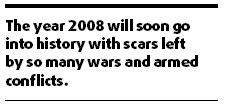The year that saw wars spread far and wide

Statistics show a total of at least 54 local wars and armed conflicts have taken place in the world in 2008, of which 11 are new, more than what the year 2007 saw in both counts.
Even yesterday Israeli warplanes pounded Gaza for a fourth day, and the Palestinian death toll rose to at least 360.
Besides this fiercest Middle East conflict since 1967, the wars and conflicts include the two protracted local wars in Afghanistan and Iraq, plus 18 armed conflicts between countries and 34 within individual countries.
Most of them are in Africa, the Middle East, Latin America and Asia with Africa having seen 24 of them, the most among all regions, followed by Asia with 14, six in the Middle East, five in the former Soviet bloc, three in Latin America and two in other regions.
All these are small-scale armed conflicts of low or medium intensity except the wars in Afghanistan and Iraq, which are medium to large-scale local wars of medium to high intensity. Although a few of them appear to be "nationwide" in one sense or another and have lasted for some time, they are low-intensity armed conflicts between government-controlled military and rebel forces nonetheless.
Except the few in nations such as Cote d'Ivoire and Niger, which have just entered ceasefire and peace talks, most of these conflicts are still going on and set to last. Some of them have been going on for a few years, such as in Pakistan, while those in countries like Somalia and Georgia have spanned more than a decade so far; but there are even longer ones, such as in Angola and Sri Lanka, where armed conflicts have been around for decades.
So many bloody fights going on despite efforts to mediate and end them, they are like painful wounds that never heal. According to statistics kept by the United Nations, the total number of refugees from wars around the world is approaching 12 million and growing everyday.
The international community has been urging the warring sides in these armed conflicts to cease fire ever since they started, including during the Beijing Olympic Games in August and the World Peace Day on Sept 21 in 2008, but to little, if any, effect. It is safe to say that wars and armed conflicts have kept the global situation under a leaden cloud of gloom throughout the year.
The ongoing wars in Afghanistan and Iraq remain the two violent affairs attracting most attention from around the world today. The Afghan War has been going on for seven years and the one in Iraq for five, with a heavy economic loss as well as human lives reaching new highs in 2008.

As of March 2008, statistics show, the number of US troops killed in action in Iraq had exceeded 4,000. It then shot up to 4,300 toward the end of the year. More than 1,000 American soldiers lost their lives in Iraq this year; while another 800 were killed in Afghanistan.
The two wars together have cost the US military over 5,000 men and women, and this does not include the more than 120 who committed suicide on the front. On top of that there is about $876 billion the US has thrown into these wars so far this year, $170 billion more than it did in 2007, with the war in Iraq alone consuming up to $648 billion in 2008.
With so much invested and so many casualties in them, what the US has got in return are two seemingly never-ending wars sucking the nation deeper into them like a "black hole". US President-elect Barack Obama went to Afghanistan and Iraq after winning the 2008 presidential election and decided to pull US forces out of Iraq as soon as possible, but said he would send more soldiers to Afghanistan.
According to the agreement on US military deployment in Iraq, American troops staying in Iraqi towns and cities will leave the Gulf nation by June 30, 2009 and the rest will get out of there before the end of 2011.
Meanwhile, according to the plan to withdraw US forces from Iraq and increase American fighting power in Afghanistan put forward by Secretary of Defense Robert M. Gates, the US military will redeploy two combat battalions from Iraq to Afghanistan in the first half of 2009 and complete a plan to add four battalions, or some 20,000 troops, to its presence in that country in the first half of 2010.
Even if the plan is accomplished as scheduled, however, the Afghan War will remain a "black hole" dragging the US into it, which even Obama, who has earned the nickname "superman born in the 1960s", cannot escape. Besides, who's to say Iraq will not fall into the abyss of civil war again after the US forces have left?
In addition to fighting two wars at the same time, the US has also launched nearly 70 "cross-border attacks" into Pakistan, Somalia and Syria. In 2008 alone, US troops deployed in Afghanistan carried out more than 60 "cross-border strikes" against targets inside neighboring Pakistan with not just attack drones to launch missile sorties but combat soldiers flown in by helicopters for ground action.
In March 2008, US warships deployed off the Somali coast fired several cruise missiles at targets in the nation's southern town of Dobley; and later, in May, the US forces in Djibouti sent an AC-130H gunship into Somali airspace to bomb "terrorist" targets in Dhusamareb township near the Kenyan border. In October the same year, US forces in Iraq dispatched four helicopter gunships to attack "terrorists" hiding on a farm in neighboring Syria, but the victims turned out to be all innocent civilians.
Such frequent "cross-border strikes" by the US military brought the flames of war to regions around Afghanistan and Iraq, effectively expanding the wars outside the two countries while stoking terrorist activities around the war zones, giving rise to a "war-terror circle" centered on the two wars but also affecting countries around them. Even worse, the closer they are to the center the greater their "terror troubles" become.
Pakistan, for example, has experienced at least 76 terrorist attacks in 2008, of which eight resulted in more than 100 deaths; in neighboring India, the terrorist massacre in Assam in October left some 361 people dead or wounded, and the one in Mumbai the following month claimed 490 casualties.
It can be said that by launching "cross-border strikes" the US not only spilled wars but also terror into neighboring countries of Afghanistan and Iraq. Although such strikes were waged in the name of eliminating Osama bin Laden, snaring terrorist leaders or destroying Al-Qaida strongholds, they killed much more innocent people than real terrorists and only a few of their leaders, while bin Laden remained as illusive as ever. No wonder those "cross-border strikes" were condemned by the majority of nations, as even the United Kingdom and France felt uncomfortable about them.
In 2008 the brief war between Russia and Georgia should be considered a more arresting duel than most others, not only because it is Russia's first military action outside its borders since the demise of the Soviet Union but also it symbolizes the resurrection of a former superpower, whose military might remains second just to the US.
On Aug 8, 2008, the day the opening ceremony of the Beijing Olympic Games was held, Georgian armed forces attacked Russian troops in the breakaway region of South Ossetia, who lost some men, with more wounded. The Russian military immediately sent support into the region and the armed conflict soon escalated as more Russian soldiers with superior fight power crossed the country's southern border into South Ossetia and fought the Georgian army for eight days. On August 16, the two sides signed an agreement on a ceasefire and the Russian forces began pulling out of the former Soviet republic.
In this conflict Russia achieved its objective by launching a "blitzkrieg" against Georgian forces with one decisive blow. The brief war was fought against the backdrop of intensifying wrestling between Russia and the US over the latter's growing military presence around the former's territory. It was apparently meant as a lesson for Georgia and to ensure the security of its neighboring region to the West, but also as a warning to the US and NATO: Don't push Russia too far.
Furthermore, it was intended to give the Russian forces an opportunity to experience real war, boost their combat-worthiness and bring back the esteem of yesteryear. As a matter of fact, since the disintegration of the Soviet Union, Russia had seen military action only in its own "backyard", such as Chechnya, Dagestan, Ingush and northern Caucasus, and the brief war against Georgia is the first the country fought outside its borders since then.
It certainly helped the Russian forces in such military capabilities as war planning, battle tactics, troop movement, strategic projection and modernization of logistics, while contributing to the foundation of Russia's new military theories with experiences in real combat.
The year 2008 will soon go into history with scars left by so many wars and armed conflicts, while 2009 is drawing near with hopes for peace and development. Seeing the old off while welcoming the new, we wish wars and armed conflicts will stay in history for good while peace and development remain current forever.
The author is a researcher at China Council for National Security Policy Studies
(China Daily 12/31/2008 page9)








